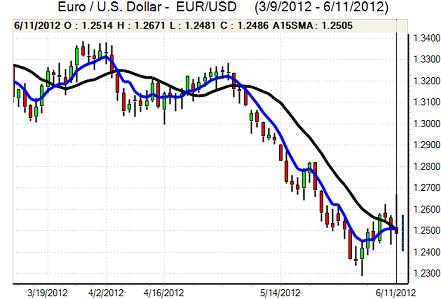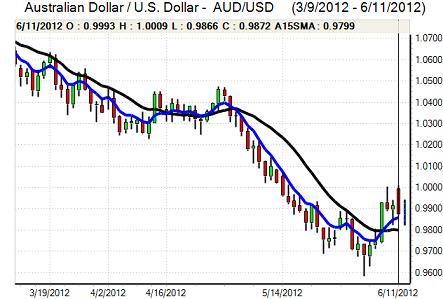EUR/USD
After peaking above 1.2650, the Euro was subjected to sustained selling pressure on Monday as confidence steadily drained away. The Spanish banking-sector bailout inevitably remained a very important focus following the weekend agreement. There was a sharp initial decline in Spanish 10-year yields to below 6.0% for the first time in three weeks before a sharp reversal during the European session as yields rose to above 6.50%.
There were uncertainties whether the bailout funds would be made available through the EFSF or the ESM and there were important reservations surrounding the ESM. Assuming the fund is ratified by all national governments and brought into operation as planned at the beginning of July, there will also be further fears that any use of ESM funding would subordinate existing private bond holders. This would lessen the attractiveness of Spanish sovereign debt and undermine the wider Spanish outlook with the threat of further capital outflows.
There was also an increase in stresses surrounding the Italian bond market with benchmark yields rising to above the 6.0% level with fears that Italy would also get drawn into a bailout. There were further protests surrounding austerity measures in Greece and an increase in fears that the more favourable terms surrounding the Spanish deal would increase the anti-austerity vote at this weekend’s Greek election.
There were no major US developments during the day with Regional Fed President Williams again stating unease over international risks to the US economy and equity markets were generally weaker. There is likely to be increased speculation over a bias towards an easier monetary policy at next week’s Federal Reserve meeting if risk appetite continues to deteriorate.
The Euro initially broke below 1.26 and lost further ground during the session with a low below 1.25 which further damaged the technical outlook as it closed below Friday’s level. There was a low near 1.2450 in Asia on Tuesday before a tentative correction.

Source: VantagePoint Intermarket Analysis Software
Call now and you will be provided with FREE recent forecasts
that are up to 86% accurate* 800-732-5407
If you would rather have the recent forecasts sent to you, please go here
Yen
The dollar was unable to make any impression above the 79.60 area against the yen on Monday and edged lower, although ranges were relatively narrow. Both currencies tended to move in tandem during the session as risk conditions dominated. There was renewed defensive yen demand as European equity markets reversed gains and peripheral bond yields increased.
If the yen strengthens significantly further, there will be additional speculation that the Bank of Japan will announce further quantitative easing at Friday’s policy meeting. The IMF also stated that the yen was still moderately over-valued and that the Bank of Japan should consider additional stimulus. The dollar found support near 79.15 following the IMF comments and moved back to the 79.50 area. Weaker than expected domestic data also contributed to a weaker Japanese currency.
Sterling
Sterling hit resistance above 1.5570 against the dollar during Monday and retreated to lows just below 1.55 during the New York session. The decline was cushioned to some extent by a Sterling recovery against the Euro as Monday’s initial losses were reversed with Sterling pushing to around 0.8065.
There will be further concerns over UK demand and also a growing political risk as tensions within the coalition increase as growth remains weak. The latest RICS house-price index registered a slight improvement to -16% from -19% previously with market volumes tending deteriorate further.
Defensive considerations will remain very important in the short term and renewed stresses within the Euro area would trigger defensive flows into Sterling. There will still be uncertainties surrounding the UK banking sector which is likely to curb support and volatility is likely to increase.
Swiss franc
The dollar found support on dips towards 0.95 against the franc on Monday and rallied firmly to a high above 0.96 as the US currency secured a wider recovery. The Euro was unable to sustain an initial advance and wider selling pressure pushed the currency back to below the 1.2010 level.
With the Euro under renewed selling pressure, there will be fresh speculation that the Swiss National Bank will resort to capital controls in order to combat flows into the currency and curb franc buying support. Tensions will continue to increase ahead of Thursday’s monetary policy meeting.

Source: VantagePoint Intermarket Analysis Software
Call now and you will be provided with FREE recent forecasts
that are up to 86% accurate* 800-732-5407
If you would rather have the recent forecasts sent to you, please go here
Australian dollar
The Australian dollar was unable to sustain a challenge on resistance levels near parity against the US currency and declined steadily during the day with a low below the 0.99 level as an early recovery in risk appetite also reversed rapidly.
There was some increase in domestic political tensions which also increased Australian currency volatility. As far as the domestic data is concerned, there was a slide in NAB business confidence to -2 for May from 4 previously which maintained a very cautious tone towards the outlook. The Australian dollar recovered from lows around 0.9850 during the Asian session.



